



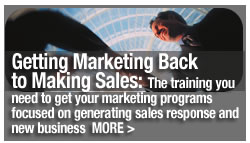 |
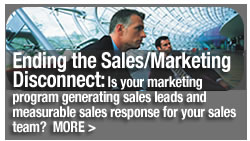 |
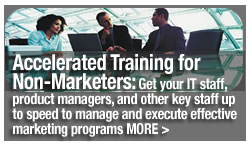 |
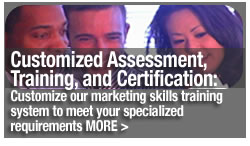 |
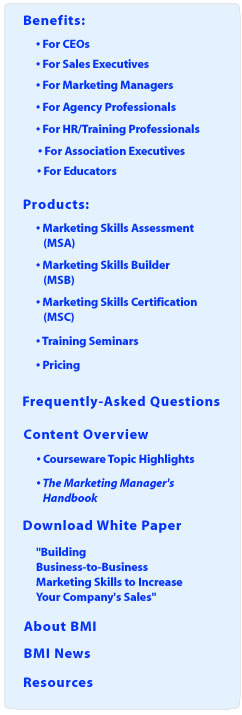
Tuesday Marketing Notes (Number 80 —May 22nd , 2007)
MAKE SURE YOU CONTINUE TO RECEIVE EACH ISSUE OF TUESDAY MARKETING NOTES—CLICK HERE TO RENEW YOUR FREE SUBSCRIPTION
(NOTE: If you’ve already signed up previously at this link, no need to do so again)
Are You a “Mosquito Marketer?” Quit Using E-Mail
to Train Your Leads to Ignore You
by Ardath Albee
In last week’s TMN, we discussed the importance of recognizing that marketing automation isn’t a “set it and forget it” process. This week, let’s address the content and the context of the e-mail messages you send to prospects during the lead nurturing process.
When you were building your Web site, of course you asked yourself these questions:
Who's going to read it?
What will they get from what they read?
What do they do after that?
What do you do in response?
So how does all that play into your interactive marketing campaigns? It's a similar process, only there's a lot more interaction with potential customers to use for fine tuning as the campaign progresses.
We all get e-mail marketing messages. There are more “deletable” ones than meaningful and informative ones. The e-mails that are instant fodder for the trash bin are the offers that get sent repeatedly with the exact same messaging. If it didn't catch your eye the first time, why would those marketers think you’d want to see the same thing 5 more times in two days?
At this point, you disengage. You may even be irritated enough to unsubscribe. Or, you’ll ignore them because you’ve been trained to know you’ll get ten more e-mail invitations for that webinar before the event date. What the marketer has done is eliminate the urgency that would have you sign up now.
This repeated messaging tarnishes the value of the prospect’s relationship with you. Marketing this way gives your prospects the leeway to waver on committing their time because, in the case of the webinar signup, for example, they know they’ll have other opportunities to register. Those marketers aren't likely to let them forget about their offer.
By “spamming” your list like this, you're training your leads to ignore you. Don’t take advantage of your prospect’s tolerance or waste their attention. Think about how you’d feel as the recipient. It's that "do unto others" rule.
The difference between being a mosquito marketer and a trusted expert is all about the content and how engaging it is. What does your recipient get, even if they don't take you up on your call to action? There should be some value delivered, even if the recipient decides not to interact by taking you up on your call to action. Never waste an opportunity to communicate something useful.
Each e-mail you send out should be different. Even if it’s for the same offer. It should be about your recipient's interests. Each message you send should provide new insights, knowledge, and opportunities for interaction because that recipient needs to know more about the subject in order to solve a problem, answer an issue or overcome a challenge.
You also need to develop additional messages to send to those who don’t respond to each of your regular e-mail messages, and alternate messages to send to those who do click through on any e-mail you send.
A month-long e-mail campaign requires quite a bit of content. Here's a typical list of the e-mail messages you’ll need to prepare for a weekly interactive e-mail campaign focused on both long and short term results:
- Four inter-related articles that build a story. The easiest way to do this is to look at your campaign from a “theme” perspective. Each successive weekly e-mail should build on that theme. Focus it from the viewpoint of what’s important to your prospects—not about your products or company. You can also use the e-mails to educate your prospects about why the status quo doesn’t work and how to think about changing that. The subtle indication is that your product is the solution. Try to help them envision the results they’ll get if they take on the change you’re promoting;
- Four e-mail messages for non-responders—one to go with each article send, and three alternate e-mail messages to go to those who did open/click-through on the first one (for a total of seven messages):
- The non-responders get the next message in the series;
- The responders get the alternate message, which should include a mention about the e-mail they’ve opened and tie that message to the next one, building a chain of recognizable interactions;
- Choice of two follow-up messages and links for each of the article sends;
- Choice of links to go with the follow-up messages
Even if you have existing links that relate to the articles for this campaign, that's still nineteen pieces of content to create a month-long campaign. Seems like a lot, right?
Here's a scenario to put these content requirements into context...
Week One:
1.) Send the first e-mail message with a link to the first article.
- (As a hypothetical example, we’ll use a technical product sold to manufacturers, and our theme will be about improving productivity. The first article in the campaign will talk about how the stalling of productivity is hurting the industry and why it’s important for their prospects to break the status quo).
2.) Monitor views and click-throughs, responding to each one individually with a follow-up e-mail message and another link to match their interest (Leave alone the ones who don't open or click through);
- In response to a prospect who reads the article, a follow-up e-mail will be sent with a case study that speaks to increasing productivity and helps the prospect envision the difference that outcome can make to them, personally, and to their ability to meet their company’s strategic goals.
Generally, you want to respond to each open or click through within 48 hours—24 hours is better. Your marketing automation system will show you which recipients are taking action. Some systems will allow you to program a rules-based auto-response, but unless you have a huge number of interactions, you’re better off taking the time to personalize your follow-up messages manually. It does make a difference, and your prospects can tell.
Utilize the intelligence you’ve gathered during the campaign to personalize messaging for best results. Take a look at which content your recipients viewed. Did they only read the article linked to in the e-mail, or did they read something else at the website or landing page? If they read something else, how does it combine with the content of the article you sent as the call to action?
Make sure you select the best follow-up message option and link, given your insights. Customize the message as needed, to personalize it for your reader. Choose the best linking option to other, related content to continue the recipient's knowledge transfer about the information they've expressed interest in.
Week Two:
- Tweak e-mail message #2, if necessary, given the feedback you've received on the previous e-mail. Send the second e-mail blast to the list of all who did not take action on your first one.
- E-mail #2 sent to the people who didn’t respond from the first week’s e-mail will refocus the issue and transition from message #1’s topic about increasing productivity, to growing velocity by removing obstacles. Same theme, but the message will be tweaked to approach productivity from a different vantage point and provide different reasoning for changing the status quo (note that the same messaging doesn’t elicit responses from everyone in the same way).
- Send the alternate message (from one of the 7 messages you developed in the initial, bulleted list previously described) for e-mail blast #2 to the list of all the recipients who clicked through and received a personalized follow-up message from you. This one may also need tweaking based on response.
- E-mail #2 for the people who did respond to the first e-mail will extend the productivity theme by focusing on how improving their department’s direct productivity will impact the entire organization and showcase those outcomes.
- Monitor views and click-throughs, responding to each one individually with a follow-up e-mail message and another link to match their interest. (Leave alone the ones who don't open or click through). One of your follow-up messages should make sure to mention the previous message and article and reinforce the story of how this new article extends from the first one they read. You should be able to leverage this information from the interest profile/activity history within your marketing automation system.
- Follow-up for those who open this e-mail might be about how to better coordinate across departments to enable the best productivity improvements, with a white paper from an expert focused on that issue. Perhaps there’s an invitation to register for a webinar on this subject, or to use an evaluation tool to assess where productivity improvements may help the prospect put these ideas into a more personalized context.
- Note if some of the recipients who open the first time, but do not view your second article—put them back into the big list of non-openers for the next send.
Repeat this process for weeks 3 and 4.
For example, in week 3, for those who still haven’t opened the e-mail, you might move on and address another topic within the same theme, such as one addressing the impact of productivity on the recipient’s outputs (or another) process
An interactive e-mail campaign is all about providing useful information to the prospect that showcases your product’s value, without being a sales pitch. The focus on a particular theme informs them about a key industry issue that can affect their success and educates them about how to assess and deal with the challenge productively. Here, the fact that you have the solution to address the issue is a bonus. To build trusted relationships, you need to share expertise and provide insights the prospect doesn’t have easily available to them.
As each communication increases their knowledge about the issue and builds the story for them, you are positioning the prospect with the knowledge they need to feel empowered to tackle the issue. You are giving them a way to enter the conversation from a position of empowerment.
Personalized, High-Quality E-Mail Interactions Develop Highly Qualified Sales Leads
What happens as you work this process is that you're continually interacting and driving conversational opportunities based on what's of interest to the lead. Not to you. This is a marketing campaign. The purpose is to transition leads through the sales funnel to the point at which sales conversations are welcomed. This process develops highly qualified leads.
By the end of week 4 you will have culled a list of engaged leads who may be ready to be transferred to the sales team for conversations (this may also be true for some leads prior to week 4; this depends on your company's lead scoring process). Along with the lead, the sales team should receive the history of the interactions, page views, and messaging that the lead has had with your company during the campaign (and, if possible all other campaigns).
Make sure you have closed-loop processes so sales can return the lead to marketing for further nurturing, if their purchase timeline is not in the near term. They should be put into a warming campaign and any information the sales team learns should be added to their history/profile. Sales should have an automatic trigger in the CRM to follow-up.
Inviting subscription to newsletters is one of the other things that can be promoted with your articles. You want to enroll them in learning from your expertise. The more quality interactions you can exchange with a lead, the better the chance for a relationship. The more a lead knows about how your company can help them, and the more satisfied they are with all interactions they have with you, the more trusted the relationship will become—which makes the transition to the sales process all the more seamless.
Interactive e-mail campaigns are a lot of work, but the payoff can be huge. The content requirements can often seem prohibitive to companies with limited marketing resources. This is where planning your campaigns pays off huge dividends. Don’t think about the mechanics of developing nineteen inter-related content pieces. Think about showcasing your company’s expertise in a way that increases your sales team’s opportunity to acquire new customers.
Here are some guidelines for developing the context of your own product’s story:
- Choose a theme, such as a universally-recognized problem in your industry that can be solved by your company’s product;
- Make sure each content resource extends from and relates to the story and theme;
- Plan your goals—make them iterative over the course of the campaign. What do you want the outcome to be? Are you driving subscriptions to your newsletter, getting people to register for a webinar, expanding their recognition of you as an expert by getting them to use your problem evaluation tool? Or, maybe, you want to gather intelligence that will help you define what types of content your prospects find useful so you can nail how to multiply interactions that build relationships.
- Monitor responses and personalize follow-up interactions;
- Ensure that each communication will be perceived as meaningful and useful by your prospects.
What makes interactive e-mail campaigns worthwhile is that, used in conjunction with Marketing Automation, the accomplishments can transform your marketing-to-sales productivity. Because you’ve leveraged the intelligence collected during your campaigns to strengthen relationships, marketing becomes an active and crucial component of your company’s sales process. The handoff to sales will be highly anticipated by sales, because salespeople will know they’re now in a position to close more deals with these more highly-developed leads.
Ardath Albee (ardath@marketinginteractions.com) is an expert marketing strategist in the field of B2B marketing. Ardath calls on over 22 years of marketing experience to empower clients to increase their marketing effectiveness, establishing marketing as a critical driver of corporate success. Her focus is on helping clients develop actionable customer relationships through leveraging contextual communication platforms. She also helps clients increase their return from in-place CRM and electronic marketing solutions, delivering an integrated and highly effective marketing system. Visit her website and industry-leading blog to learn more: www.marketinginteractions.com.
Real Marketing: The Skills You Need for Business-to-Business Marketing Success, a 47-page overview of content covered by the BMI MSA/B/C Training and Certification System
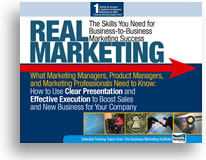



Login![]() Home
Home![]() Free Demo
Free Demo![]() Free Newsletter
Free Newsletter![]() Order Now
Order Now![]() Contact Us
Contact Us
Copyright 2005-2007 Business Marketing Institute, LLC

